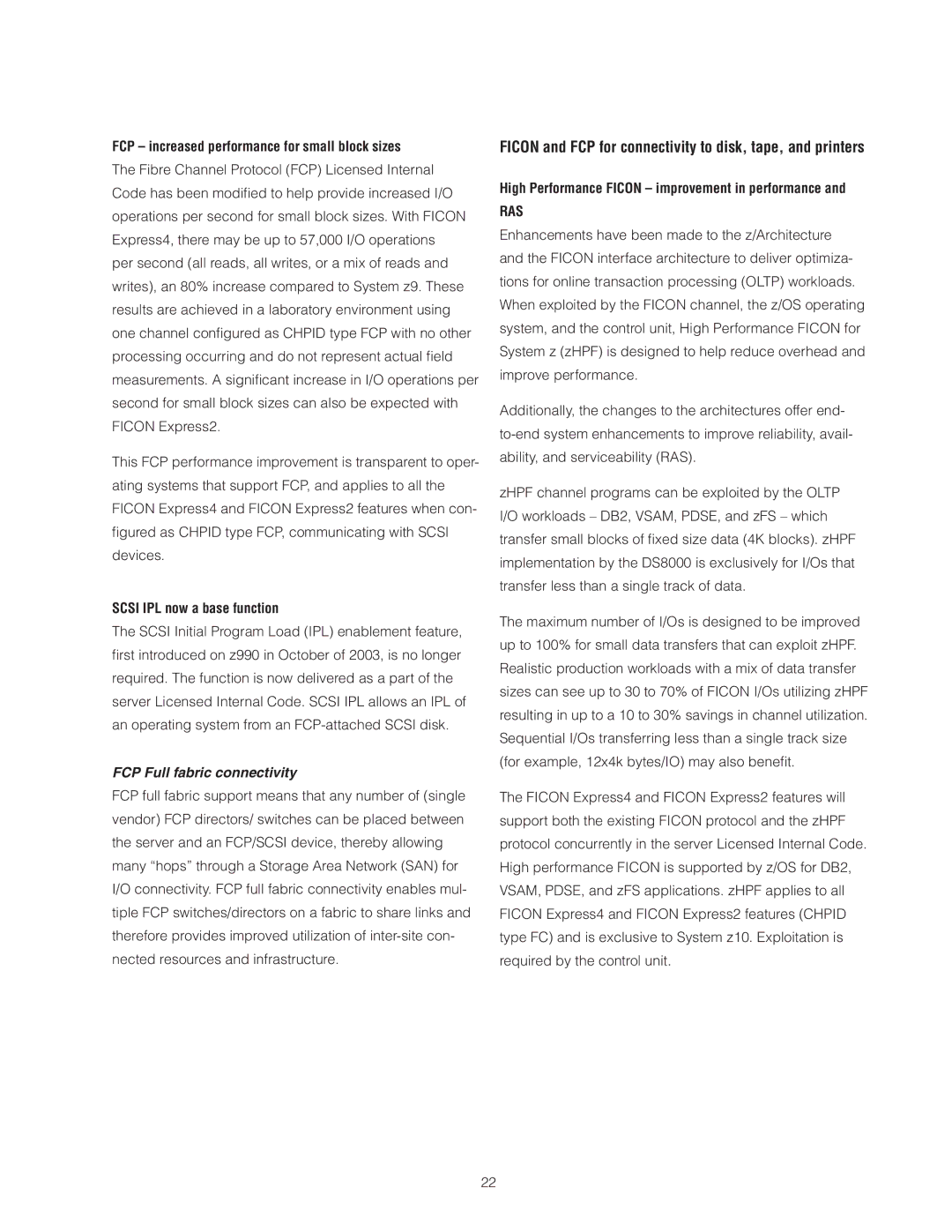FCP – increased performance for small block sizes
The Fibre Channel Protocol (FCP) Licensed Internal Code has been modifi ed to help provide increased I/O operations per second for small block sizes. With FICON Express4, there may be up to 57,000 I/O operations per second (all reads, all writes, or a mix of reads and writes), an 80% increase compared to System z9. These results are achieved in a laboratory environment using one channel confi gured as CHPID type FCP with no other processing occurring and do not represent actual fi eld measurements. A signifi cant increase in I/O operations per second for small block sizes can also be expected with FICON Express2.
This FCP performance improvement is transparent to oper- ating systems that support FCP, and applies to all the FICON Express4 and FICON Express2 features when con-
figured as CHPID type FCP, communicating with SCSI devices.
SCSI IPL now a base function
The SCSI Initial Program Load (IPL) enablement feature,
first introduced on z990 in October of 2003, is no longer required. The function is now delivered as a part of the server Licensed Internal Code. SCSI IPL allows an IPL of an operating system from an
FCP Full fabric connectivity
FCP full fabric support means that any number of (single vendor) FCP directors/ switches can be placed between the server and an FCP/SCSI device, thereby allowing many “hops” through a Storage Area Network (SAN) for I/O connectivity. FCP full fabric connectivity enables mul- tiple FCP switches/directors on a fabric to share links and therefore provides improved utilization of
FICON and FCP for connectivity to disk, tape, and printers
High Performance FICON – improvement in performance and
RAS
Enhancements have been made to the z/Architecture and the FICON interface architecture to deliver optimiza- tions for online transaction processing (OLTP) workloads. When exploited by the FICON channel, the z/OS operating system, and the control unit, High Performance FICON for System z (zHPF) is designed to help reduce overhead and improve performance.
Additionally, the changes to the architectures offer end-
zHPF channel programs can be exploited by the OLTP I/O workloads – DB2, VSAM, PDSE, and zFS – which transfer small blocks of fi xed size data (4K blocks). zHPF implementation by the DS8000 is exclusively for I/Os that transfer less than a single track of data.
The maximum number of I/Os is designed to be improved up to 100% for small data transfers that can exploit zHPF. Realistic production workloads with a mix of data transfer sizes can see up to 30 to 70% of FICON I/Os utilizing zHPF resulting in up to a 10 to 30% savings in channel utilization. Sequential I/Os transferring less than a single track size (for example, 12x4k bytes/IO) may also benefi t.
The FICON Express4 and FICON Express2 features will support both the existing FICON protocol and the zHPF protocol concurrently in the server Licensed Internal Code. High performance FICON is supported by z/OS for DB2, VSAM, PDSE, and zFS applications. zHPF applies to all FICON Express4 and FICON Express2 features (CHPID type FC) and is exclusive to System z10. Exploitation is required by the control unit.
22
